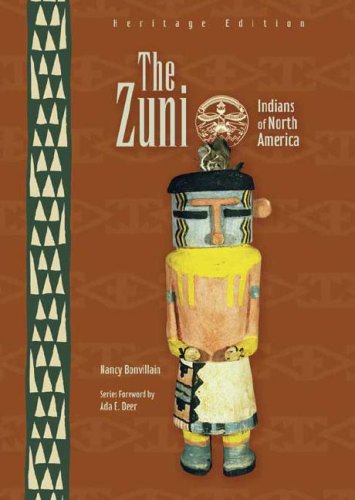-
The Aztecs
Frances F. Berdan
Paperback (Chelsea House Pub, Oct. 1, 1988)Examines the culture, history, and changing fortunes of the Aztec Indians
-
Native Americans of the Great Lakes
Stuart Kallen
Hardcover (KidHaven, Nov. 10, 2003)Discusses Native American peoples of the Great Lakes region and their customs, family life, organizations, food gathering, beliefs, housing, and other aspects of daily life. V
V
-
Native Peoples of the Plains
Linda Lowery
Library Binding (Lerner Publications, Aug. 1, 2016)A long time ago, before the Plains region of the United States was divided up into states such as Nebraska, Colorado, and Wyoming, this land was home to American Indians. Twenty-eight unique Indian nations built homes and gathered food in the Plains. They spoke distinct languages, set up political systems, and made art. They used the natural resources available in their region in order to thrive. • The Wichita lived in houses made of grass. From the outside, they looked like giant haystacks. • Omaha and Ponca people wore caps made from eagleskin. • Lakota men carved flutes to play songs for the girls they hoped to marry. Many American Indians still live in the Plains region. Explore the history of these various nations and find out how their culture is still alive today. X
X
-
Native Peoples of the Southeast
Linda Lowery
Library Binding (Lerner Publications, Aug. 1, 2016)Who were the first people to call the southeastern United States home? Long before Europeans came to the region, American Indian nations lived off the rich and varied land. These peoples had different languages, governments, and cultures. Their traditions and heritage were shaped by the climate and terrain of the American Southeast. • The Caddo traveled in canoes made from the wood of cypress trees. • The Seminole wove baskets from sweetgrass and dyed them with berries, nuts, and roots. • The Cherokee danced with rattles made of turtle shell strapped to their legs in what is called a stomp dance. Twenty-first century American Indians still call the Southeast home. Find out what these groups have in common and what makes each nation unique. X
X
-
Native Peoples of the Northwest
Krystyna Poray Goddu
Library Binding (Lerner Publications, Aug. 1, 2016)A thin strip of land and islands makes up the Pacific Northwest coast of the United States and Canada. This region has long been home to many groups of native peoples who spoke different languages and had distinct cultural practices. The native peoples of the Northwest thrived in this land of rocky beaches and cedar trees. • The Chinook developed a special language for trading with other nations. • The Kwakwaka'wakw created masks that could show two different faces. • The Bella Coola had a secret society that performed in a four-night winter ceremony. Many native peoples still live in the Northwest and continue to fish, carve totem poles, and work to preserve their land and cultures. Learn more about the unique history and cultures of the native peoples of the Northwest. X
X
-
Cheyenne
Stan Hoig
Library Binding (Chelsea House Pub, Nov. 1, 1988)Traces the history of the Cheyenne, describes their culture, and looks at their interaction with whites
-
The Zuni
Nancy Bonvillain
Library Binding (Chelsea House Pub, Sept. 1, 2005)The Zuni was the first Pueblo tribe to encounter the Spanish, when Franciscan missionaries entered present-day western New Mexico in the late 1530s. They are one of the few tribes in North America that has remained largely autonomous. They still reside in their original homeland and have been able to hold on to many of their customs and beliefs. Y
Y
-
Buffalo Boy
Edna Walker Chandler, Jack Merryweather
Hardcover (Benefic Press, March 15, 1957)"It was spring again in the land of the Plains Indians. The snow was all goen from the flat ground, but there was still snow on the hills. One Elk saw the snow on the far away hills, but he knew another winter was past. When he looked the other way, toward the plains, he saw new, green, buffalo grass. But he did not see one buffalo!"
-
The Navajo: A Proud People
Allison Lassieur
Library Binding (Enslow Elementary, Oct. 1, 2005)Describes the history, clothing, homes, and everyday life of the Navajo people, often comparing the traditional to the modern. P
P
-
The Cherokee
Catherine M. Petrini
Hardcover (KidHaven, Oct. 20, 2003)Discusses the Cherokee people, their customs, family, organizations, food gathering, religion, war, housing, and other aspects of daily life. S
S
-
Native Peoples of the Subarctic
Stuart A. Kallen
Library Binding (Lerner Publications, Aug. 1, 2016)As early as the 1500s, fur traders from Europe began to arrive in the Subarctic region of North America. These traders were greeted by the many groups of native peoples already living in the region. These native peoples had their own languages, cultures, and methods for hunting and surviving in this land where it snowed 200 days a year. Many native peoples still live throughout the Subarctic. They are working to revive their traditions and languages and preserve the land. Read more about the history and culture of the native peoples of the Subarctic. X
X
-
The Santee Sioux Indians
Terrance Dolan
Paperback (Chelsea House Pub, Oct. 1, 1996)Examines the history and present status of the Santee Sioux Indians, discussing their fight to maintain their native lands P
P